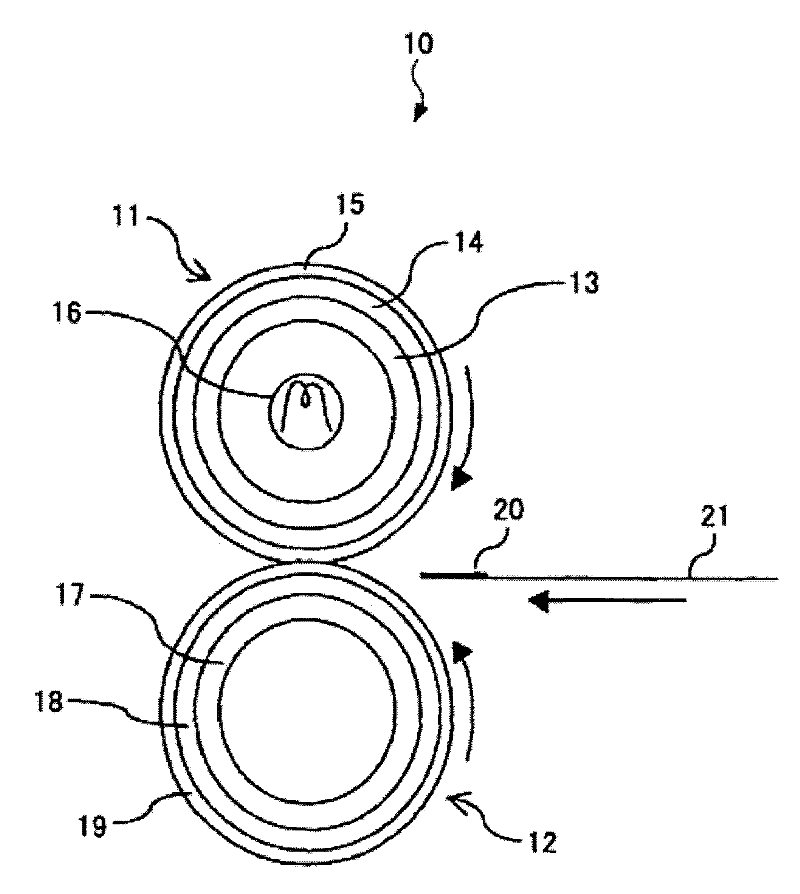Electrostatic image developing toner and two-component developer
A technology for electrostatic image development and toner, which is applied in the directions of developers, electrographics, instruments, etc., can solve the problem of insufficient wax dispersion, retention, anti-offset separation resistance, high temperature storage and filming resistance improvement Insufficient and other problems, to achieve the effect of excellent storage and improved dispersion
- Summary
- Abstract
- Description
- Claims
- Application Information
AI Technical Summary
Problems solved by technology
Method used
Image
Examples
Embodiment 1
[0145]
[0146] Into the reaction kettle equipped with cooling tube, stirrer and nitrogen gas introduction tube, pour 690 parts of bisphenol A ethylene oxide (2mol) adduct and 335 parts of terephthalic acid, make it in the normal pressure nitrogen flow The condensation reaction was carried out at 210°C for 10 hours. Thereafter, while removing water under a reduced pressure of 10 mmHg to 15 mmHg, the reaction was continued for 5 hours, followed by cooling, whereby polyester (1) was obtained. The obtained polyester (1) had a weight average molecular weight of 6,000 and an acid value of 10 KOHmg / g and a glass transition temperature of 48°C.
[0147]
[0148] The following components were poured into a reaction kettle equipped with a cooling pipe, a stirrer and a nitrogen gas introduction pipe, and allowed to undergo a condensation reaction at 210° C. for 8 hours in an atmospheric nitrogen flow.
[0149]
[0150]Next, while removing water under a reduced pressure of 10 mmH...
Embodiment 2
[0163]
[0164] Into a reaction kettle equipped with a cooling pipe, a stirrer, and a nitrogen gas introduction pipe, 622 parts of hydroxyl-terminated polybutadiene (product name: POLY BD R-15HT, manufactured by Idemitsu Kosan Co., Ltd., number average molecular weight : 1,200, hydroxyl value: 102.7 mg KOH / g) and 378 parts of terephthalic acid were subjected to condensation reaction at 200° C. for 9 hours in a nitrogen stream at normal pressure. Then, while removing water under a reduced pressure of 10 mmHg to 15 mmHg, the reaction was continued for 5 hours, and then cooled, thereby obtaining a resin (2) having a polyolefin skeleton (hereinafter referred to as "polyolefin skeleton-containing resin (2)") . The obtained polyolefin skeleton-containing resin (2) had a weight average molecular weight of 1,830.
[0165] Subsequently, pour 660 parts of bisphenol A ethylene oxide (2mol) adducts and 340 parts of terephthalic acid into a reaction kettle equipped with a cooling pipe, ...
Embodiment 3
[0170]
[0171] The production process was implemented in the same manner as in Example 1, except that 14.3 parts of prepolymer (1), 54 parts of polyester (1) and 1.1 parts of block copolymer (2) were mixed into 78.6 parts of ethyl acetate, and then Stir and dissolve, then add 6.0 parts of paraffin wax as a release agent, 4 parts of copper phthalocyanine blue pigment, and 2 parts of organically modified montmorillonite. Thus, toner (3) was obtained.
PUM
| Property | Measurement | Unit |
|---|---|---|
| glass transition temperature | aaaaa | aaaaa |
| glass transition temperature | aaaaa | aaaaa |
| glass transition temperature | aaaaa | aaaaa |
Abstract
Description
Claims
Application Information
 Login to View More
Login to View More - R&D
- Intellectual Property
- Life Sciences
- Materials
- Tech Scout
- Unparalleled Data Quality
- Higher Quality Content
- 60% Fewer Hallucinations
Browse by: Latest US Patents, China's latest patents, Technical Efficacy Thesaurus, Application Domain, Technology Topic, Popular Technical Reports.
© 2025 PatSnap. All rights reserved.Legal|Privacy policy|Modern Slavery Act Transparency Statement|Sitemap|About US| Contact US: help@patsnap.com



